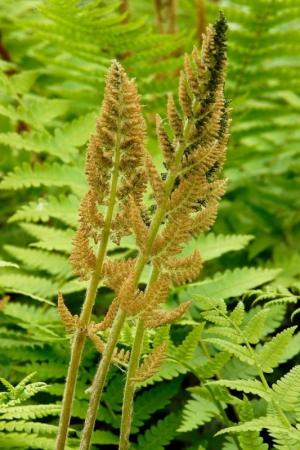Cinnamon may have been around for thousands of years thanks to the Romans spreading it around, using cinnamon sticks as an incense and to flavor wine.
But it took the ingenious Swedes to make buns chock-full of raisins, slathered with sugar icing, and generous helpings of cinnamon (the ground-up bark of Cinnamomum cassia), and the cinnamon bun was born.
To work off your own cinnamon or other buns, you can easily grow the cinnamon fern (Osmundastrum cinnamomeum). The cinnamon fern, once planted, grows with almost no maintenance. It is common in moist areas such as bogs, swamps and low-lying fields because it thrives in wet soils.
Cinnamon fern gets its name from the fronds that take on a cinnamon color when they are fertile and about to release spores. The graceful fronds grow four to five feet tall, and each plant will droop to cover several feet across.
The Abnaki and Menominee Indians ate the newly emerging shoots or 'fiddleheads' every spring. Farther west, the Cherokee used cinnamon fern leaves as medicine to treat colds, congestion, and even snakebites.
Plant cinnamon ferns in full to partial shade. Try to find a spot with moist soil, but if not, you can grow them perfectly well with additional watering. You can even grow cinnamon ferns in very large pots using a rich potting soil with added compost.
Since they’re native to much of Canada, the United States, Mexico and Central America, you can often find them for sale at local nurseries or by mail order from companies such as Greenwood Nursery (www.greenwoodnursery.com or phone 800-426-0958) or Prairie Nursery (P.O. Box 306, Westfield, WI 53964, phone 800-476-9453).
They grow best in acidic loam; they will tolerate any soil if you add compost or peat moss.
These are strikingly beautiful ferns with two-toned fronds emerging from dense clumps growing out of shallow, black rhizomes. The larger, outer leaves bend slightly to form a vase-like enclosure protecting the inner, smaller, fertile leaves. The outer leaves are a soothing light to medium green on fronds that can reach five-and-a-half feet in length.
Starting in early May into June, the fertile fronds emerge first, and will last all the way through the winter. Even after some of the most delicate fronds die off from autumn frost, you will be treated to an artful contrast in colors and textures, making the cinnamon fern a year-round beauty.
These are very hardy, low-upkeep plants that once established will give you years of lush, soothing fronds, with each frond reaching up to five feet feet tall. They are a natural choice to plant on the north side of your house or plant several at the base of shade trees. You can use the foliage as a lush filler in floral bouquets.
Probably best of all, cinnamon ferns are deer-resistant and will almost never be eaten by deer or other pests. While you won't get the spice cinnamon from cinnamon ferns, you will get a soothing, relaxing perennial that can calm you no matter how many cinnamon buns you eat.




















































